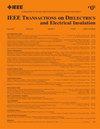非沸腾液氮的纳秒放电
IF 3.1
3区 工程技术
Q2 ENGINEERING, ELECTRICAL & ELECTRONIC
IEEE Transactions on Dielectrics and Electrical Insulation
Pub Date : 2025-03-20
DOI:10.1109/TDEI.2025.3571687
引用次数: 0
摘要
对非沸腾液氮的纳秒放电进行了研究。放电是在阻抗为的同轴波导的中心导体的间隙中开始的 $50~\Omega $ . 差距在10 -以内变化 $100~\mu $ m.波导的电介质和放电介质为常压和温度为65k的未沸腾的液氮。电压脉冲的幅值为+/ -12-25 kV,持续时间为7 ns,电压上升时间为150 ps,发现放电电流的前缘小于80 ps $\nu _{i}$ 大于 $7.5\cdot 10^{{10}}$ ${\mathrm {s}}^{-{1}}$ 电离速率常数 ${k} _{i}$ 大于 $4.2\cdot 10^{-{12}}$ 立方厘米 ${\mathrm {s}}^{-{1}}$ 在不沸腾的液氮中,温度为65k。在波导放电间隙后检测到一个振幅约为10 kV、持续时间约为150 ps的通过电磁耦合波。对电磁耦合波的形成进行了数值模拟。测量了放电延迟时间与间隙电场的关系。的形成 $20~\mu $ 在电极表面发现了M大小的侵蚀坑,表明微爆炸过程可能在放电机制中起作用。本文章由计算机程序翻译,如有差异,请以英文原文为准。
Nanosecond Discharge in Non-Boiling Liquid Nitrogen
Nanosecond discharge has been studied in non-boiling liquid nitrogen. The discharge is initiated in the gap in the central conductor of a coaxial waveguide with an impedance of $50~\Omega $ . The gap varied within 10– $100~\mu $ m. The dielectric of the waveguide and the discharge medium is non-boiling liquid nitrogen at atmospheric pressure and temperature 65 K. The amplitude of the voltage pulse is +/–12–25 kV, the duration is 7 ns, the voltage rise time is 150 ps. It is found that the leading edge of the discharge current is less than 80 ps. According to estimates, the electron ionization rate $\nu _{i}$ is more than $7.5\cdot 10^{{10}}$ ${\mathrm {s}}^{-{1}}$ and the ionization rate constant ${k} _{i}$ is more than $4.2\cdot 10^{-{12}}$ cm3 ${\mathrm {s}}^{-{1}}$ in non-boiling liquid nitrogen at 65 K. A passing electromagnetic coupling wave with amplitude about 10 kV and duration 150 ps is detected behind the discharge gap in the waveguide. The formation of electromagnetic coupling wave is numerically demonstrated. The dependence of the discharge delay time on the electric field in the gap is measured. The formation of $20~\mu $ m size erosion craters is found at the surface of the electrodes demonstrating the possible role of the micro-explosive processes in the discharge mechanism.
求助全文
通过发布文献求助,成功后即可免费获取论文全文。
去求助
来源期刊
CiteScore
6.00
自引率
22.60%
发文量
309
审稿时长
5.2 months
期刊介绍:
Topics that are concerned with dielectric phenomena and measurements, with development and characterization of gaseous, vacuum, liquid and solid electrical insulating materials and systems; and with utilization of these materials in circuits and systems under condition of use.

 求助内容:
求助内容: 应助结果提醒方式:
应助结果提醒方式:


